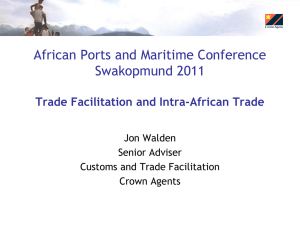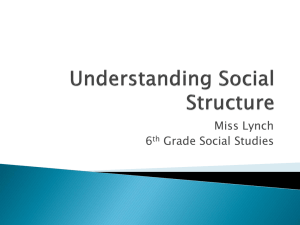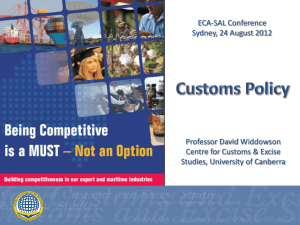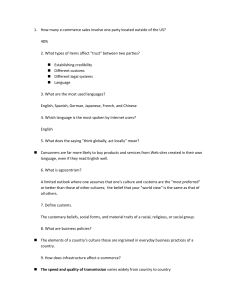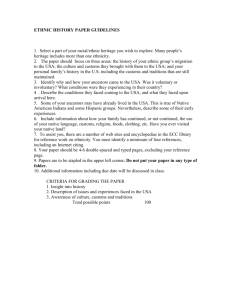Customs Modernization Driving Forces
advertisement
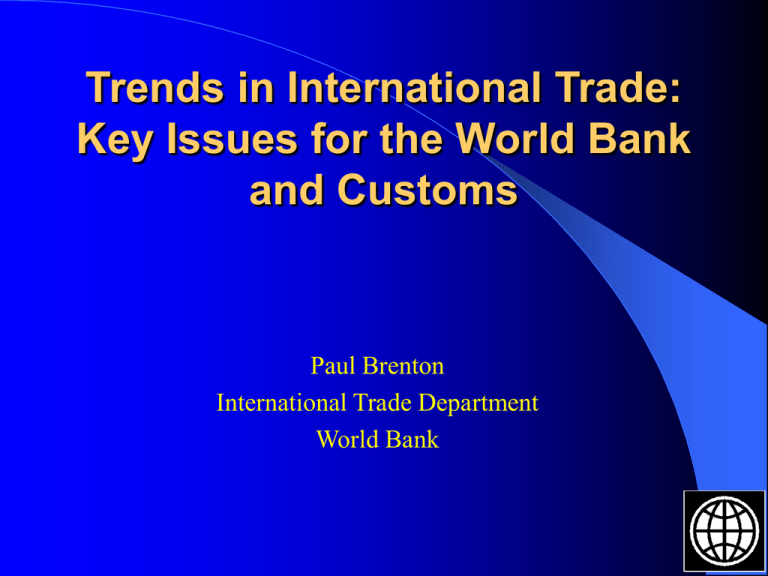
Trends in International Trade: Key Issues for the World Bank and Customs Paul Brenton International Trade Department World Bank OUTLINE What is the World Bank ? What do we do on trade? Research, advocacy, advice, lending. Why are we interested in Customs and trade facilitation ? Key trends in trade that will shape our work and the work of Customs What is the World Bank? Global co-operative owned by its 184 shareholders or member countries – Run by a Board of Governors The Bank is a UN Specialized Agency Development agency that provides policy advice, TA, knowledge sharing and development finance 11254 staff in 111 countries In FY 04 - IDA - $9 b – 158 projects - 62 countries In FY 04 - IBRD - $11 b – 87 projects – 33 countries Trade can be a powerful engine of growth and poverty reduction Levers for Intervention Before the border (Improving overseas market access, reforming domestic trade policy) At the border (Trade Facilitation – Regulatory and procedural harmonization, simplification and institutional reform) Behind the border (Improving the investment climate, improving trade and transport infrastructure, dealing with supply side constraints) WHAT IS THE BANK DOING ON TRADE? Research, analysis and advocacy Elevating Trade to a prominent role in Country Policy Dialogue Established Trade Department including Trade Logistics Group – Bringing together Trade Policy, Infrastructure and Customs/Border Management teams Stepping up trade–related operations Aid for trade? Why is the World Bank interested in Customs? Customs plays a critical role in trade facilitation. The costs of crossing borders now seen as a more significant barrier than tariff rates. Customs performs other important functions such as revenue collection, community protection and, increasingly, national security Customs can act as an effective integrator to ensure all trade and border related agencies work together to simplify and harmonize systems and procedures The Bank believes productive investment in Customs modernization delivers sound development results More efficient customs are associated with more trade Ratio of total trade to GDP, 90 countries % 200 150 100 R2 = 0.1354 50 0 0 5 10 15 20 25 Days through customs, imports Source: WBES and Global Trends as cited in Subramanian, et al 2003 30 35 What is the Bank doing on Customs? Stressing importance of Customs in policy dialogue Established the Trade Logistics Group Building a broader constituency for reform • Global Facilitation Partnership for T & T, Diagnostic Trade Integration Studies, Trade and Transport Facilitation Audits, Trade Facilitation Seminars Coordination of donors & international organizations Customs Modernization Handbook Stepping up operations Bank Operations - Some current examples: Russian Customs Modernization Project ($ 140 m) Vietnam Customs Modernization Project ($ 75 m) Tanzania Tax Administration Project ($ 70 m - WB, UNCTAD, DANIDA, DFID, EU, FINNIDA, SIDA & IMF) Cambodia Trade Facilitation and Competitiveness project ($ 10 m - WB, EU & AUSAID) EAC Trade Facilitation Project ($30 m) Despite improvements in trade policies, many Countries Have Been Left Behind The experience of individual countries varies greatly 43 countries had no expansion of exports between 1980 and 2000 Increase in market share mainly associated with today’s Middle Income Countries Much growth in South – South trade Key issues in Bank research and analysis on trade Global trade agenda Regionalism Asia Standards Speed with security Global integration Technological change and splitting up of production chains will continue to drive greater trade and capital flows. Labour? Global companies seeking out lowest cost locations More countries are seeking to integrate into global markets The global market enacts a high price on those not using competitively supplied inputs “Success” in Doha Round will still leave much to be done at global level Possible gains in real income in 2015 as percent of full multilateral liberalization for LMICs (excluding services and trade facilitation) 100 90 Full 80 70 60 50 40 30 Tiered cuts w/ SDT w/ 2% exclusions 20 10 0 Low & Middle Income Tiered SDT ~ 70% in HICs and 40 in LMICs in ag, plus NAMA cuts of 50% in HICs, 33 in LMICs; and 0 in LDCs Regional Trade Agreements are proliferating… Annual number 30 25 20 Annual number 15 10 5 0 1958 1969 1976 1984 1989 1994 1999 2004 Regional Trade Agreements are proliferating… Annual number Total in force 30 300 25 250 Cumulative in force 20 200 New agreements annually 15 150 10 100 5 50 0 0 1958 1969 1976 1984 1989 1994 1999 2004 South-South RTAs predominate in number, but not in trade covered Number of RTAs Percent of World Trade Covered 250 35 30 200 25 SouthSouth 150 SouthSouth 20 15 100 US 10 US 50 5 European Union 0 1990 1996 European Union 0 2002 1990 1996 2002 RTAs can help address trade facilitation issues RTAs can offer a mechanism to deal with cross-border issues: – Customs simplification, cooperation, harmonisation……. – Transport cooperation, harmonisation of regulations, insurance…. But, many RTAs have yet to deliver better trade facilitation Proliferation of PTAs is leading to a complex global trading system American and Asian Spaghetti “ Bowl - FTAA Hong Kong PR China Taiwan Canada Brunei Costa Rica Cambodia CACM Panama El Salvador Korea Guatemala Honduras Nicaragua Thailand Malaysia Japan Mercosur Paraguay Argentina Brazil USA Uruguay Philippines Mexico Myanmar Bolivia ASEAN Singapore Colombia New Zealand Chile Venezuela Laos Ecuador Indonesia Australia Peru Vietnam FTAA APEC APEC Papua New Guinea Intra -Americas in force Intra -Asia -Pacific in force Intra -Asia -Pacific signed Trans -Pacific signed Source: Devlin and Estevadeordal (2004) Russia Andean Community Bahamas Dominican Republic CARICOM Dominica Trinidad & Tobago Suriname Grenada Barbados Jamaica St. Vincent & Grenadines Guyana Antigua & Barbuda St. Kitts & Nevis Belize Haiti St. Lucia Overlapping African agreements… AMU Nile River Basin COMESA ECCAS IGAD CEMAC Somalia Sao Tomé & Principe Algeria Libya Morocco Mauritania Tunisia ECOWAS Conseil de L’Entente Ghana Nigeria Egypt Cameroon Central African Rep. Gabon Equat. Guinea Rep.Congo Chad Cape Verde Gambia Djibouti Ethiopia Eritrea Sudan Burundi* Rwanda* DR Congo Benin Togo Cote d’Ivoire Guinea-Bissau Liberia Sierra Leaone Niger Burkina Faso Mali Senegal EAC Guinea Tanzania* Malawi* Zambia* Zimbabwe* SACU WAEMU Mano River Union Kenya* Uganda* Angola CLISS AMU: Arab Maghreb Union CBI: Cross Border Initiative CEMAC: Economic & Monetary Community of Central Africa CILSS: Permanent Interstate Committee on Drought Control in the Sahel COMESA: Common Market for Eastern and Southern Africa EAC: East African Cooperation ECOWAS: Economic Community of Western African Studies IGAD: Inter-Governmental Authority for Government IOC: Indian Ocean Commission SACU: Southern African Customs Union SADC: Southern African Development Community WAEMU: West African Economic & Monetary Union South Africa Botswana Lesotho Mozambique SADC Mauritius* Syechelles* Comoros* Madagascar* Namibia* Swaziland* Reunion *CBI IOC Different agreements with different rules of origin add complexity Proliferating trade agreements with differing ROO further complicate customs procedures •clearance of preferential imports requires more manpower •overlapping rules of origin cause particular difficulties for customs Need Clear and consistent ROO with minimal costs a) to firms in adhering to them and b) to customs in implementing them How about satisfying either a 10% value added requirement OR change of tariff classification (6 digit HS) Examples of Complex and Restrictive ROO EU imports of Fish To receive preferences under the GSP •The vessel must be registered in the beneficiary country or in the EU •The vessel must sail under the flag of the beneficiary or of a member state of the EU •The vessel must be at least 50 per cent owned by nationals of the beneficiary country or the EU •The master and the officers must be nationals of the beneficiary country or an EU member •At least 75 per cent of the crew must be nationals of the beneficiary country or the EU. The Rise of Asia East Asia’s share of worlds (non-oil) imports has risen from 2.7% in 1980 to 10.6% in 2004 East Asia was the key source of export growth for Africa in 1990s Opportunities and challenges – Tremendous mass of fast growing demand (emerging tri-polar world): key to improved market access is global negotiation – Increasing competition in export and domestic markets: Need to distinguish unfair from effective competition. (Perceived) Lack of border control can undermine efforts towards trade liberalisation. The Rising Importance of NonTraditional Exports……. Figure 3 : Changing Structure of Developing Country Agro-food Exports Share in Total Agro-food Exports 100% Other Other 80% C ereal,o il seeds, feed C ereal,o il seeds, feed 60% High value commodities High value commodities 40% 20% M ajo r traditio nal co mmo dities M ajo r traditio nal co mmo dities Other C ereal,o il seeds, feed High value commodities M ajo r traditio nal co mmo dities 0% 80/81 90/91 03/04 …brings greater demands in terms of standards…. Competitiveness depends on capacity to satisfy both mandatory (SPS/TBT) and private standards in export markets Standards in developed countries are shaping expectations of consumers in developing countries …and increased need for timeliness to be competitive. Increasing importance of air transport (30% of US imports now come by air) For many products, globalisation means that to be competitive exporters require access to imported inputs at world prices Increasing impetus to hold lower inventories Security – secure trade is now as important as free trade, and the two need not be mutually exclusive Particular problems for land-locked countries Still much to be done to improve trade facilitation in developing countries Average number of days to clear customs for sea cargo Developed East Asia and Pacific Latin America and Caribbean Africa South Asia India Bangladesh 0 2 4 6 8 10 12 Source: International Exhibition Logistics Associates, based on a sample of countries in each region as cited in World Bank Global Economic Prospects 2004; country data from World Bank country surveys 14 Conclusions Increasing emphasis on customs as a border management institution to facilitate timely and secure trade Bank a key source of research and operational experience on trade issues Trade facilitation essential element of Bank’s agenda on trade and poverty reduction
